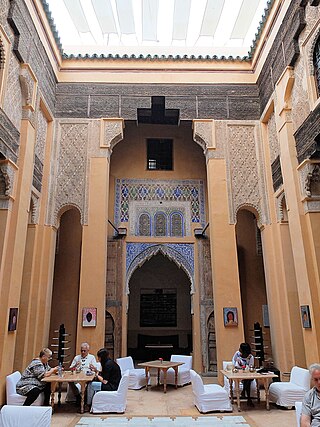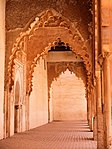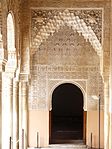
A riad or riyad is a type of garden courtyard historically associated with house and palace architecture in the Maghreb and al-Andalus. Its classic form is a rectangular garden divided into four quadrants by two paved paths intersecting in the center, where a fountain is typically situated. The planted areas are usually sunken below the level of the paths. Its origin is generally attributed to traditional Persian gardens whose influence spread during the Islamic period. The term "riad" is nowadays often used in Morocco to refer to a hotel or guesthouse-style accommodation with shared common areas and private rooms, often within a restored traditional mansion.

Moroccan architecture reflects Morocco's diverse geography and long history, marked by successive waves of settlers through both migration and military conquest. This architectural heritage includes ancient Roman sites, historic Islamic architecture, local vernacular architecture, 20th-century French colonial architecture, and modern architecture.

The Kutubiyya Mosque or Koutoubia Mosque is the largest mosque in Marrakesh, Morocco. It is located in the southwest medina quarter of Marrakesh, near the Jemaa el-Fnaa market place, and is flanked by large gardens.

Moorish architecture is a style within Islamic architecture which developed in the western Islamic world, including al-Andalus and what is now Morocco, Algeria, and Tunisia. Scholarly references on Islamic architecture often refer to this architectural tradition in terms such as architecture of the Islamic West or architecture of the Western Islamic lands. The use of the term "Moorish" comes from the historical Western European designation of the Muslim inhabitants of these regions as "Moors". Some references on Islamic art and architecture consider this term to be outdated or contested.

Stucco decoration in Islamic architecture refers to carved or molded stucco and plaster. The terms "stucco" and "plaster" are used almost interchangeably in this context to denote most types of stucco or plaster decoration with slightly varying compositions. This decoration was mainly used to cover walls and surfaces and the main motifs were those predominant in Islamic art: geometric, arabesque, and calligraphic, as well as three-dimensional muqarnas. Plaster of gypsum composition was extremely important in Islamic architectural decoration as the relatively dry climate throughout much of the Islamic world made it easy to use this cheap and versatile material in a variety of spaces.

The Aljafería Palace is a fortified medieval palace built during the second half of the 11th century in the Taifa of Zaragoza in Al-Andalus, present day Zaragoza, Aragon, Spain. It was the residence of the Banu Hud dynasty during the era of Abu Jaffar Al-Muqtadir. The palace reflects the splendor attained by the Taifa of Zaragoza at its height. It currently houses the Cortes of the autonomous community of Aragon.

The Bou Inania Madrasa or Bu 'Inaniya Madrasa is a madrasa in Fes, Morocco, built in 1350–55 CE by Abu Inan Faris. It is the only madrasa in Morocco which also functioned as a congregational mosque. It is widely acknowledged as a high point of Marinid architecture and of historic Moroccan architecture generally.

The Al-Attarine Madrasa or Medersa al-Attarine is a madrasa in Fes, Morocco, near the Al-Qarawiyyin Mosque. It was built by the Marinid sultan Uthman II Abu Said in 1323-5. The madrasa takes its name from the Souk al-Attarine, the spice and perfume market. It is considered one of the highest achievements of Marinid architecture due to its rich and harmonious decoration and its efficient use of limited space.

Almohad architecture corresponds to a period from the 12th to early 13th centuries when the Almohads ruled over the western Maghreb and al-Andalus. It was an important phase in the consolidation of a regional Moorish architecture shared across these territories, continuing some of the trends of the preceding Almoravid period and of Almoravid architecture.

The Ben Youssef Mosque, is a mosque in the Medina quarter of Marrakesh, Morocco, named after the Almoravid emir Ali ibn Yusuf. It is arguably the oldest and most important mosque in Marrakesh.

The Kasbah Mosque, also known as the Moulay al-Yazid Mosque, is a historic mosque in Marrakesh, Morocco. It was originally built by the Almohad ruler Yaqub al-Mansur in 1185–1190 CE. It is located in the Kasbah district, the city's former citadel, near the site of its historic royal palaces. Along with the Kutubiyya Mosque, it is one of the most important historic mosques in Marrakesh.

The architecture of Fez, Morocco, reflects the wider trends of Moroccan architecture dating from the city's foundation in the late 8th century and up to modern times. The old city (medina) of Fes, consisting of Fes el-Bali and Fes el-Jdid, is notable for being an exceptionally well-preserved medieval North African city and is classified as a UNESCO World Heritage Site. A large number of historic monuments from different periods still exist in it today, including mosques, madrasas, synagogues, hammams (bathhouses), souqs (markets), funduqs (caravanserais), defensive walls, city gates, historic houses, and palaces.

The Bab Doukkala Mosque or Mosque of Bab Doukkala is a major neighbourhood mosque in Marrakesh, Morocco, dating from the 16th century. It is named after the nearby city gate, Bab Doukkala, in the western city walls. It is also known as the al-Hurra Mosque.

The Mouassine Mosque or al-Muwassin Mosque is a major neighbourhood mosque in Marrakech, Morocco, dating from the 16th century during the Saadian dynasty. It shares its name with the Mouassine neighbourhood.

The Tinmal Mosque or Great Mosque of Tinmal is a 12th-century mosque located in the village of Tinmel in the High Atlas Mountains of Morocco. Although no longer operating as a mosque today, its remains are preserved as a historic site. It was built at the site where Ibn Tumart, the founder of the Almohad movement, was buried and it is considered an important example of Almohad architecture.

Dar Cherifa, historically known as Dar Ijimi, is a late 16th-century house in the medina of Marrakesh, Morocco. It is located in the Mouassine neighbourhood and is one of the few well-preserved houses from the Saadian period in the city. In recent years it has been restored and is now used as a café and art gallery.

Almoravid architecture corresponds to a period from the 11th to 12th centuries when the Almoravids ruled over the western Maghreb and al-Andalus. It was an important phase in the development of a regional Moorish architecture, as the styles and craftsmanship of al-Andalus were further imported and developed in North Africa. The Almoravids founded the city of Marrakesh as their capital and built many mosques in the region, although much of what they built has not preserved. The Almoravids were overthrown by the Almohads in the 12th century, after which Almohad architecture continued to develop some of the same trends in the Maghreb and al-Andalus.

Traditional houses in Morocco are usually centered around a large internal courtyard, the wast ad-dar, and are characterized by a focus on interior decoration rather than on external appearance. The houses of wealthy residents featured decoration typical of Moroccan architecture and medieval Moorish architecture, including carved and painted wood, carved stucco, and zellij. The center of larger houses could also be occupied by a riad garden, particularly in places like Marrakesh where more space was available.

The mixtilinear arch is a decorative (non-structural) arch with intrados comprised of rounded and straight segments connected at angles, its outline sometimes resembles a shaped gable.

























